Polarization Diversity Antennas for Compact Base Stations
This article describes the use of diversity reception for mobile radio base stations and compares the performance of space and polarization diversity techniques. In urban areas polarization diversity offers performance that is generally comparable with that of space diversity. The compact three-antenna system of a polarization diversity base station is much more acceptable as a feature of the urban landscape. Performance trials in rural areas show a less clear picture: While most experimenters report that space diversity is a superior method, others have obtained results favoring polarization diversity. This article discusses possible reasons for these differences.
Brian S. Collins
CSA Ltd., Rochester, Kent, UK
The mobile radio environment is characterized by small, low power mobile units operating with low transmitted power and restricted antenna performance communicating with a base station that has a much higher operating power and more freedom to deploy high gain antennas. The radio path from mobile to base station is often physically blocked by buildings, trees and terrain features. As a mobile user moves through the environment, the signal received at the base station varies with time because the amplitudes and phases of the directly received signal and multiple reflected signals change from moment to moment. For some proportion of the total time, the received signal may fall to an unacceptably low level and the resulting reduction in bit error rate (BER) (or Eb /No ) will cause loss of effective communication.
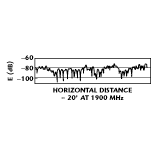 Several years ago it was determined that the reliability of communication in a time-varying transmission environment can be improved by receiving the signal on two or more independent channels (known as branches since they both relate to the same communications channel) and combining the output in some optimum manner. Methods used include branches separated by time (send everything more than once since fades will probably not occur at the same point in both transmissions), frequency (send signals on more than one frequency at the same time since fades will be independent), space (receive the signals at two separate locations where fades will be independent), polarization (if the transmission medium has the property of coupling signals between polarizations, then the signals are unlikely to fade at the same time) and/or angle (signals received at different arrival bearings have a different scattering and reflection history and probably will not fade together).
Several years ago it was determined that the reliability of communication in a time-varying transmission environment can be improved by receiving the signal on two or more independent channels (known as branches since they both relate to the same communications channel) and combining the output in some optimum manner. Methods used include branches separated by time (send everything more than once since fades will probably not occur at the same point in both transmissions), frequency (send signals on more than one frequency at the same time since fades will be independent), space (receive the signals at two separate locations where fades will be independent), polarization (if the transmission medium has the property of coupling signals between polarizations, then the signals are unlikely to fade at the same time) and/or angle (signals received at different arrival bearings have a different scattering and reflection history and probably will not fade together).
As an example, Figure 1 shows a typical graph displaying the way in which the signal received on a base station antenna changes as the mobile user moves along a street. At several points the received signal falls momentarily below some threshold at which an acceptable Eb /No is obtained. Figure 2 shows a second receiving antenna receiving the same mean signal level, but the moments at which fades occur on the first antenna generally occur at different moments from fades on the second antenna. (Note that the fades on the two branches generally occur at different times since they occur randomly in each branch -- only those marked with a dot occur together.)
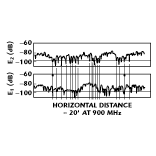 With any diversity system the property to be exploited is the lack of correlation between fades on each branch of the system. The methods can be used separately or in combination. In digital systems, diversity methods are further combined with coding systems, which allow correction of errors caused by short losses of signal. This article is concerned with a comparison between two-branch systems using either space or polarization diversity.
With any diversity system the property to be exploited is the lack of correlation between fades on each branch of the system. The methods can be used separately or in combination. In digital systems, diversity methods are further combined with coding systems, which allow correction of errors caused by short losses of signal. This article is concerned with a comparison between two-branch systems using either space or polarization diversity.
Diversity Gain
The effectiveness of a diversity system is measured by a quantity known as diversity gain. In a single-branch system the level of signal that is exceeded for some fraction of time (for example, 90 percent) can be measured. Now consider the diversity system and again examine the system output and determine the signal level exceeded for the same proportion of the available time. The increase in the signal level available for the same proportion of time (reliability) is known as the diversity gain. It is important that the reliability is quoted together with the diversity gain since different values of diversity gain are obtained when a different reliability is chosen.
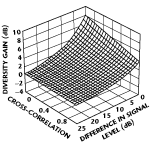 For a given reliability, diversity gain is a function of two parameters: the correlation between the signals in the two diversity branches and their relative amplitudes. The relationship between these parameters for a two-branch system is shown in Figure 3 .2 The largest diversity gain is achieved when the mean levels of the signals from the two branches are equal and the correlation between them is low -- fading is independent in the two branches. (When the correlation between signals is high, fades occur together and the system simply has 3 dB more signal power than the single-branch system. When the amplitude of one channel is much lower than the other, diversity gain falls to zero.)
For a given reliability, diversity gain is a function of two parameters: the correlation between the signals in the two diversity branches and their relative amplitudes. The relationship between these parameters for a two-branch system is shown in Figure 3 .2 The largest diversity gain is achieved when the mean levels of the signals from the two branches are equal and the correlation between them is low -- fading is independent in the two branches. (When the correlation between signals is high, fades occur together and the system simply has 3 dB more signal power than the single-branch system. When the amplitude of one channel is much lower than the other, diversity gain falls to zero.)
Diversity gain is also a function of the method by which the signals in the two branches are combined. The usual systems are selection (choose the input with the highest signal-to-noise ratio (SNR) or (S + N)/N), equal gain (combine the branch signals coherently with equal gain in each branch), switched (switch channels when the signal falls below a threshold) and maximal ratio (combine the branch signals coherently, applying a weighting to their amplitudes in accordance with the BER in each branch). Maximal ratio combining is the most effective method in a multipath environment because it makes optimal use of the total signal power received in both branches at any instant. The method is commonly (but not universally) used in mobile radio systems and its use is assumed in this article except where otherwise stated.
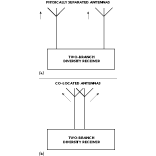 Polarization Diversity Systems
Polarization Diversity Systems
Figure 4 shows two diversity methods in the uplink radio path. In a space diversity system the two branches receive signals from physically separate locations. In a polarization diversity system the signals are received at the same location, but with orthogonal polarizations. Space diversity has been the most commonly used method since the inception of mobile services, but there is increasing interest in polarization diversity systems because the two receiving antennas can be physically co-located. This setup results in lower costs and a smaller visual profile for the base station.
Polarization Characteristics of the Received Signal
The instantaneous polarization of the signal received from the mobile user is determined by the polarization of the signal radiated from the mobile and the scattering characteristics of the transmission path. Changes in orientation of the mobile unit will change the transmitted polarization. If the path is cluttered by multiple scatterers, the received polarization will change randomly with time as the mobile unit moves through the environment.
 Figure 5 shows typical states of the received polarization. Most of the time the polarization is elliptical with arbitrary orientation (polarization angle) and ellipticity (axial ratio). This condition is to be expected. When a linearly polarized signal with an inclined polarization plane is reflected from either a horizontal or a vertical surface, the resulting sum of direct and reflected waves has elliptical polarization. There is no simple antenna that can receive all of the power transmitted in a wave with time-varying polarization. One strategy to exploit the situation is to use two antennas that respond independently to two orthogonal components of the incoming wave. The signals associated with each polarization component can be regarded as the inputs to a two-branch diversity system and fading in the two channels is at least partially uncorrelated. By appropriately combining these branches, effective use can be made of all the signal power available at any instant and a useful level of diversity gain can be obtained.
Figure 5 shows typical states of the received polarization. Most of the time the polarization is elliptical with arbitrary orientation (polarization angle) and ellipticity (axial ratio). This condition is to be expected. When a linearly polarized signal with an inclined polarization plane is reflected from either a horizontal or a vertical surface, the resulting sum of direct and reflected waves has elliptical polarization. There is no simple antenna that can receive all of the power transmitted in a wave with time-varying polarization. One strategy to exploit the situation is to use two antennas that respond independently to two orthogonal components of the incoming wave. The signals associated with each polarization component can be regarded as the inputs to a two-branch diversity system and fading in the two channels is at least partially uncorrelated. By appropriately combining these branches, effective use can be made of all the signal power available at any instant and a useful level of diversity gain can be obtained.
The effectiveness of the diversity scheme will depend on the correlation between the signal levels in polarizations chosen for the two receive branches. The lowest correlation between branches and the highest total output power can be obtained by choosing to receive two orthogonal polarization components. (Orthogonality is a complex mathematical concept, but is familiar from two simple limiting cases of a pair of linear polarizations mutually at right angles and circular polarization with left-hand and right-hand rotation. The orthogonality of two wave polarizations is measured in decibels and is the relative level received when an antenna perfectly matched to one polarization is illuminated by the other.8,9 )
Diversity Gain in a Polarization Diversity System
The effectiveness of the polarization diversity system will now be examined. Some simple examples will indicate the difficulty of arriving at clear conclusions without resorting to experimental data.
If the polarization transmitted from the mobile unit is vertical, scattering from buildings and the ground will have little effect on signal polarization because the reflected signals are also vertically polarized. Fades will occur when multipath signal components interfere destructively, but no significant coupling will exist between polarizations. If in this case a vertical/horizontal pair of polarizations is chosen for the receiving antennas, one of these channels (vertical) will receive most of the signal power and the other (horizontal) will receive a much lower level. Even if the samples were uncorrelated the diversity gain will be small. If a pair of linear polarizations inclined at ±45° is received, the signal levels will be very similar to one another and will have high correlation; each channel will contain half the total signal power. If the polarization of the signal radiated by the base station is oblique, then each reflection of the signal will result in coupling between all possible polarization states and the received signal will have the time-varying polarization characteristics shown previously for instantaneous polarization. (The same conclusion obviously applies when the mobile radiates with any nonlinear polarization.)
In a real environment the correlation between the orthogonal received polarizations depends both on the transmitted polarization and the extent of scattering of the signal in the transmission path. The difference between transmitted vertical (0°) and 45° polarizations arises because buildings present predominantly vertical reflecting surfaces and refracting edges; ground reflection of a vertically polarized signal does not couple the signal to horizontal polarization. A polarization of +45° couples to -45° at each reflection at walls or on the ground. In general, in a rural environment there will be fewer scatterers and their characteristics will be different from scatterers in cities.
Comparative Diversity Gain Using Space and Polarization Diversity
Several experimental comparisons between space diversity and polarization diversity in mobile radio systems have been reported. The results show broad qualitative agreement; the classification of environments is approximate and may account for some of the discrepancies between investigations. An urban environment in downtown Chicago is entirely different from one in Paris, France or Melbourne, Florida. Suburban means one thing in Denver, Colorado and something entirely different in terms of the height and density of buildings in Hope, Arkansas or Stockholm, Sweden. Similarly, rural does not distinguish forested area, cornfields, mountains or flat plains. When specific locations are mentioned by investigators, their classification often appears to be very arbitrary. No reference is made to the height of buildings or the presence of trees or open spaces in many cities.
Results from a well-documented study in Stockholm, Sweden4 are shown in Table 1 . These results are typical of several studies in that polarization diversity usually appears slightly inferior to space diversity.10 As expected from the previous discussion, polarization diversity using a receive antenna polarization of ±45° is superior to that obtained when the receiving antennas are horizontally and vertically polarized. Space diversity provides higher diversity gain in urban areas than it does in other environments, which might be expected since there are more scatterers in urban environments and a maximal ratio combiner will make use of all the received signal energy added coherently.
|
Table 1 | ||
|
|
Urban |
Suburban |
|
Space diversity (dB) |
6.5 |
5.0 |
|
Polarization diversity (dB) | ||
|
±45 |
-1.6 |
-0.9 |
|
H/V |
-2.6 |
-1.1 |
|
Reduction in diversity gain | ||
|
±45 (mean signal reduction) |
|
-2.5 |
|
H/V (unbalanced signals) |
|
-3 |
|
90% reliability, 90% confidence | ||
The arguments above suggest that while low correlation is obtained between space diversity branches, much of the available signal power is lost in the orthogonal polarization to which the receiving antenna does not respond. A combined four-branch space/polarization diversity system would provide significantly higher diversity gain. Wahlberg’s comparison between urban and suburban areas is at variance with most other investigations.4 Usually, diversity gain is greater in urban areas than in suburban areas. However, the city area in which he worked is characterized by regular street blocks with buildings of moderate height, while the suburbs had several high rise buildings and a less regular street plan.
Donaldson and his fellow workers5 used a vertically polarized antenna on their mobile unit and a horizontal/vertical (H/V) polarization pair at the base station. The mean reduction in diversity gain for polarization diversity vs. space diversity in Washington, DC and Richardson, Texas was 0.5 dB. In suburban trials conducted by Fuerter in California,7 polarization diversity emerged as superior to space diversity. Fuerter and Joyce note that the decorrelation between an H/V pair is always greater than between a ±45° pair, but as the signal levels in the two branches become less equal the slant-polarized option has higher diversity gain. The diversity gain of both space diversity and polarization diversity systems falls as the mobile unit moves from the antenna boresight to the sector edge. This aspect is examined in more detail in Appendix A .
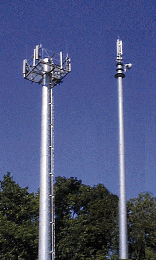 Practical Considerations
Practical Considerations
Polarization diversity has an outstanding practical advantage over space diversity because the two antennas required can be housed in a single unit no larger than that required for simple vertical polarization. As shown in Figure 6 , a number of factors result in substantially lower cost and a significantly reduced visual impact. No head frame is required on the supporting structure, thus the wind load to be supported by the structure is much lower. In addition, the structure can be of lighter design and installation times are reduced.
Conclusion
Although there are some discrepancies between the findings of different investigators, in most situations there appear to be only small differences between the diversity gain obtained using space diversity and that obtained using polarization diversity. Any small differences appear less significant as networks become more developed since base stations are added to provide additional capacity rather than to increase the geographical area of coverage. The visual profile of a base station using three dual-polar antennas is much smaller than that of a conventional space diversity base station using six antennas, and the costs of the dual-polar antennas and their supporting structure are substantially lower. In a cluttered urban environment, four-branch diversity (space and polarization) is likely to provide significantly higher diversity gain than either technique used separately.
References
1. F.Y. Ling, “Matched Filter-bound for Time-discrete Multipath Rayleigh Fading Channels,” IEEE Transactions Com ., Vol. 43, No. 2/3/4, February/March/April 1995.
2. A.M.D. Turkmani, A.A. Arowojolu, P.A. Jefford and C.J. Kellett, “An Experimental Evaluation of the Performance of Two-branch Space Diversity Schemes at 1800 MHz,” IEEE Trans. Veh. Tech ., Vol. VT-44, No. 2, May 1995, pp. 318-326.
3. F. Adachi, M.T. Feeney, A.G. Williamson and J.D. Parsons, “Cross-correlation between the Envelopes of 900 MHz Signals Received at a Mobile Radio Base Station Site,” Proceedings of the IEE , Vol. 133, Pt. F, No. 6, October 1986, pp. 506-513.
4. U. Wahlberg, “Polarization Diversity for Cellular Base Stations at 1800 MHz,” MSc thesis, Chalmers University, Sweden, 1997.
5. P. Donaldson, R. Ferguson, E. Kmiec and R. Voss, Space vs. Polarization Diversity Gain in 2 GHz PCS 1900 , MCI Telecommunications Corp., Richardson, TX.
6. J. Black, “Comparison of Space and Polarization Diversity 800 MHz Cellular Antenna Systems by Empirical Measurements,” presented at IEEE chapter meeting in Richardson, TX, September 11, 1997.
7. M. Fuerter, “A Comparison of Spatial Diversity, V/H Polarization Diversity and Slant 45 Polarization Diversity Schemes at 1900 MHz,” paper communicated privately by the author.
8. B.S. Collins, An Investigation of the Effect of Imperfect Antenna Cross-polar Performance on the Diversity Gain of a Two-branch Polarization-diversity Receiving System , CSA Ltd., Rochester, UK (to be published).
9. B.S. Collins, Measuring the Orthogonality of the Signals Radiated and Received by a Dual-polar Antenna , CSA Ltd., Rochester, UK (to be published)
10. R.M. Joyce, D.E. Barker, M.A. McCarthy and M.T. Feeney, “A Study into the Use of Polarization Diversity in a Dual-band 900/1800 MHz GSM Network in Urban and Suburban Environments,” International Conference on Antennas and Propagation (ICAP ‘99) Proceedings , 1999.
Brian Collins graduated from University College London in 1962 and has been the technical director of CSA Ltd. since 1978. His early work was on antenna systems for broadcast and military applications. During the last 10 years, he has been active in the mobile radio field where he has led the development of microstrip techniques for base station applications. Collins has been granted 12 UK patents and three US patents for original contributions to antenna design. He can be reached via e-mail at briancollins@csauk.com.
Appendix A
Diversity Gain at the Sector Edge 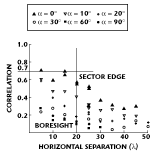
In many reports, no mention is made of whether the sample points lay in the middle of the azimuth beam of the receiving antenna or close to the ±60° azimuth directions where the beams of adjacent sectors overlap. In general, the polarization orthogonality of a dual slant-polar antenna will fall at the beam edge, typically to around 10 dB at ±60°. Two effects reduce the relative effect of this falloff. First, the diversity gain of a space-diversity system also falls off at ±60° as the lateral spacing between the antennas is reduced when viewed obliquely. Spacing along the line of the transmission path is less effective than transverse spacing across the path. These effects are shown in Figure A1 . (For a given lateral spacing, signal correlation increases as the azimuth bearing increases, thus, diversity gain at the sector edge is less than at boresight.) Figure A2 shows the signal power and corresponding Eb/No (the effective SNR in a digital system).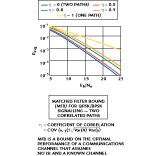 The upper curve indicates the performance of a system in which both channels receive the same signal, that is, the correlation between the two paths h is 1. The bottom curve indicates the performance of a two-branch system where the signals in the two channels are completely uncorrelated (h = 0). What is of great significance is that as the correlation between the two branches is allowed to increase, the performance of the system degrades only slowly, thus, for h = 0.5 only a very small reduction in performance occurs relative to the ideal situation. In general, it is understood that a correlation coefficient of 0.7 is acceptable for most practical systems because the difference between 0.7 and 0 is very small.
The upper curve indicates the performance of a system in which both channels receive the same signal, that is, the correlation between the two paths h is 1. The bottom curve indicates the performance of a two-branch system where the signals in the two channels are completely uncorrelated (h = 0). What is of great significance is that as the correlation between the two branches is allowed to increase, the performance of the system degrades only slowly, thus, for h = 0.5 only a very small reduction in performance occurs relative to the ideal situation. In general, it is understood that a correlation coefficient of 0.7 is acceptable for most practical systems because the difference between 0.7 and 0 is very small.
